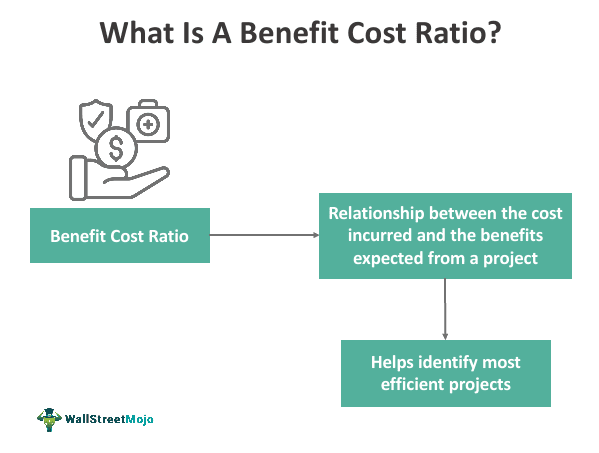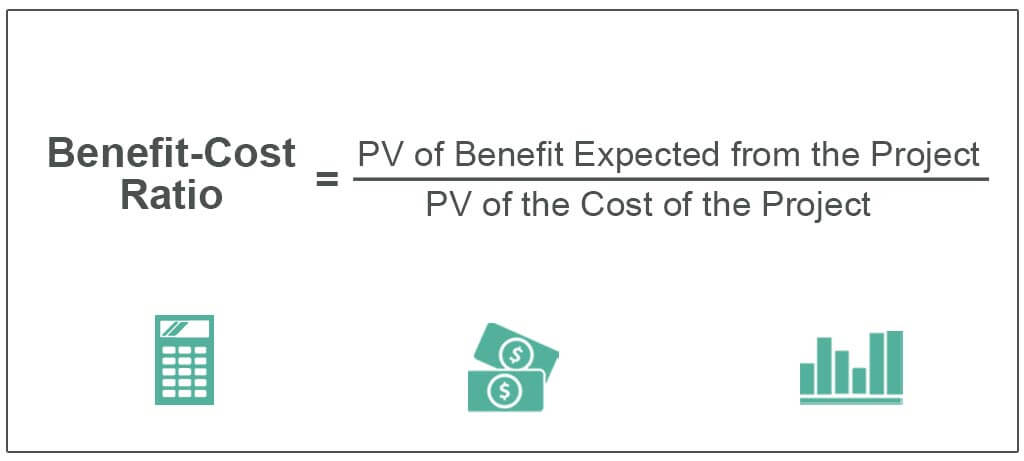Table Of Contents
What Is Benefit-Cost Ratio?
The Benefit-Cost Ratio (BCR) indicates the relationship between the cost and benefit of project or investment for analysis as it is shown by the present value of benefit expected divided by present value of cost which helps to determine the viability and value that can be derived from investment or project.

BCR is the indicators that allows firms to calculate the expected cash flow to be generated when an amount is invested in a project. It is the study of benefits against the cost to tell the firms how fruitful a project would be in accordance with the expenditure made on accomplishing it successfully.
Benefit Cost Ratio Explained
Benefit cost ratio refers to the ratio of the expected benefits and the cost incurred. The value obtained enables entities to learn about the returns that they can expect out of a project. The BCR figure enables firms check on the projects undertaken and find out the profits expected to be generated from it. They can compute this ratio and determine the cost benefits of undertaking a particular project.
Though BCR plays a significant role, it does not offer an accurate return value that firms would generate. It gives only an estimate. Hence, firms have to validate the prediction by determining other ratios as well to figure out the approximate profit generation expected from a project.
A BCR which is greater than one indicates the investment proposal will deliver a positive NPV. On the other hand, it shall have an IRR that would be above the discount rate or the cost of project rate, which will suggest that the Net Present Value of the investment’s cash flows will outweigh the Net Present Value of the investment’s outflows and the project can be considered.
If the Benefit-Cost Ratio (BCR) is equal to one, the ratio will indicate that the NPV of investment inflows will equal investment’s outflows. Lastly, if the investment’s BCR is not more than one, the investment’s outflow shall outweigh the inflows or the benefits, and the project should not be taken into consideration.
However, simply following a rule that success means above one and failure or reject decision would mean BCR below one can be misleading and lead to a misfit with the project in which heavy investment is made. Hence, the BCR should be used as a conjunctive tool with different types of analysis as the use of NPV, IRR, other qualitative factors, and then make a good decision.
Formula
The mathematical expression that lets one calculate BCR value for proper benefit cost ratio analysis is mentioned below:
Benefit-Cost Ratio Formula = PV of Benefit Expected from the Project / PV of the Cost of the Project

- If that investment or the project has a BCR value that is greater than one, the project can be expected to return or deliver a positive NPV, i.e., net present value to the business or the firm and their investors.
- If BCR value is less than 1, then the project cost can be expected to higher than the returns, and therefore, it should be discarded.
How To Calculate?
To calculate the BCR formula, use the following steps:
Step 1: Calculate the present value of the benefit expected from the project. The procedure to determine the present value is:
- The amount for each year = Cash Inflows*PV factor
- Aggregate the amounts for all the years.
Step 2: Calculate the present value of costs. If the costs are incurred upfront, the cost incurred is the present value of the expenses as there is no PV factor.
Step 3: Calculate the benefit-cost ratio using the formula:
- BCR formula = PV of Benefit Expected from the Project / PV of the Cost of the Project
Examples
Let us consider the following instances to understand the benefit cost ratio definition better:
Example #1
EFG ltd is working upon the renovation of its factory in the upcoming year, and for they expect an outflow of $50,000 immediately, and they expect the benefits out of the same for $25,000 for the next three years. The inflation rate that is currently prevailing is 3%. You are required to assess whether the decision to renovate will be profitable by using a BCR.
Solution
To do the cost-benefit analysis first, we need to bring both costs and benefit in today's value. Since the outflow of $50,000 is immediate and hence that would remain the same.
Since the gains are in future value, we need to discount them back by using a discount rate of 3%.
Therefore, the Benefit-Cost Ratio can be calculated as using the below formula as,

The formula for Calculating BCR = PV of Benefit expected from the Project / PV of the cost of the Project
= 70715.28 /-50,000.00
BCR =1.41
Since the Benefit-Cost ratio is greater than 1, the renovation decision appears to be beneficial.
Example #2
Sunshine private limited has recently received an order where they will sell 50 tv sets of 32 inches for $200 each in the first year of the contract, 100 air condition of 1 tonne each for $320 each in the second year of the contract, and the third year they will sell 1,000 smartphones valuing at $500 each. But to fulfill this requirement, they need to increase the production, and for that, they are looking for a cash flow of $35,000 to hire people on contract. All this will be deposited in a separate escrow account explicitly created for this purpose and cannot be withdrawn for any other purpose. Still, the company will earn a 2% rate on the same for the next three years as the same will be paid at the end of 3rd year to the contract employees.
Further, the cost of production that will be incurred in the 1st year will be $6,500. In the 2nd year, it will be 75% of the gross revenue earned, and in the last year will be 83% of the gross income as per the estimates. You are required to calculate the benefit-cost ratio and advise whether the order is worthful? Assume the cost of the project is 9.83%.
Solution
To do the cost-benefit analysis first, we need to bring both costs and benefit in today's value. Since here the costs are also incurred in different years, we need to discount them as well.
Before discounting, we need to compute total cash flows for the entire project life.
There is no cash outflow or inflow in the 0 years as the company is making a deposit and its earning interest on the same at the rate of 3%, and in the final year, the company will make a payment of $35,000, which has been included in the cash outflow.
| Year | Cash Outflow | Cash Inflow | Interest Earned | Total Cash Flows |
|---|---|---|---|---|
| 0 | - | - | - | - |
| 1 | -6500.00 | 10000.00 | 700.00 | 4200.00 |
| 2 | -24000.00 | 32000.00 | 700.00 | 8700.00 |
| 3 | -450000.00 | 500000.00 | 700.00 | 50700.00 |
Now we can discount the cash flows at 9.83% and arrive at the discounted benefit and discounted cost per below:
Therefore, the Benefit-Cost Ratio can be calculated as using the below formula as,

Benefit-cost ratio = PV of Benefit expected from the Project /PV of the cost of the Project
= 414783.70 / -365478.43
Benefit-Cost Ratio=1.13
Since it is greater than 1, the mega order appears to be beneficial.
Example #3
The Mayor of a city is evaluating two transportation projects – Project A and Project B. Project A - The present value of the benefits expected from the project is $40,00,000. The present value of costs is $20,00,000. Project B – The present value of benefit expected from the project is $60,00,000. The present value of costs is $20,00,000. Calculate the benefit-cost ratio and evaluate which project should be undertaken.
Solution
Project A
Use the following data for calculation of the benefit-cost ratio.
| Particulars | Amount |
|---|---|
| Present Value of Benefit Expected from Project | 4000000 |
| Present Value of Cost of the Project | 2000000 |

- =4000000/2000000

Project B
Use the following data for calculation of the benefit-cost ratio.


- =6000000/2000000

- BCR = 3
Since the BCR of Project B is higher, Project B should be undertaken.
Example #4
A company will have to incur a cost of $1,00,000 if new machinery is purchased. It will lead to the following extra profits in the following years:
| Year | Profit |
|---|---|
| 2016 | $40,000 |
| 2017 | $50,000 |
| 2018 | $50,000 |
Assuming a discounting rate of 3%, calculate a benefit-cost ratio of the proposed investment.
Solution:
Step 1: Calculate the Present Value Factor. Insert the formula =1/((1+0.03))^1 in cell C9.

Step 2: Insert the relevant formula in cells C10 and C11.

Step 3: Insert formula =B9*C9 in cell D9.

Step 4: Drag the formula from cell D9 up to D11.

Step 5: Insert the formula =SUM(D9: D11) in cell D12

Step 6: Insert the formula =-D12/B8 in cell D13.

Step 7: Press Enter to get the Result

Advantages and Disadvantages
Benefit cost ratio is an important parameter that helps firms identify the prospects of investing in or taking up a project. This, in turn, lets them consider the projects that are fruitful with respect to the cost incurred. Determining such costs has its own set of advantages and disadvantages. Let us have a look at them in brief below:
Pros
- The benefit of using the benefit-cost ratio (BCR) is that it helps to compare various projects in a single term and helps to decide faster which projects should be preferred and which projects should be rejected.
- It compares benefit and cost at the same level that is it considers the time value of money before giving any outcome based on absolute figures as there could be a scenario that the project appears to be lucrative without considering time value and when we consider time value, the benefit-cost ratio goes less than 1.
Cons
- The major limitation of the BCR is that since it reduces the project to mere a number when the failure or success of the projector of expansion or investment etc. relies upon various variables and other factors, and those can be weakened by events which are unforeseen.
Benefit Cost Ratio vs NPV
Benefit cost ratio (BCR) and net present value (NPV) are two terms that are interrelated when it comes to firms finding their profit prospects out of successful completion of a project. Let us have a look at the differences between the two below:
- BRC helps firms identify the cost and revenue relationship, while NPV is the sum of all the benefits, materialistic and non-materialistic, less the cost.
- While the former is an estimare, which may or may not turn to be right, the latter is the net benefit, which is almost true to the best possible extent.
- The higher the benefit cost ratio value, the better it is as it indicates better returns when expenditure is made on a project. On the contrary, a positive value of net present value derived is appreciated as it signifies net benefits, which equals to significant profit generation for the firms.


